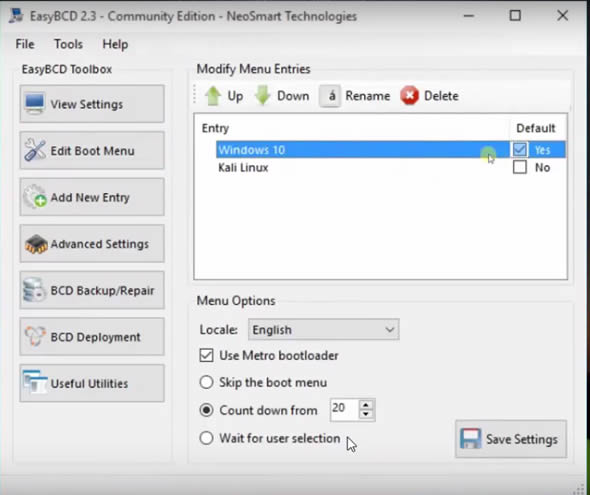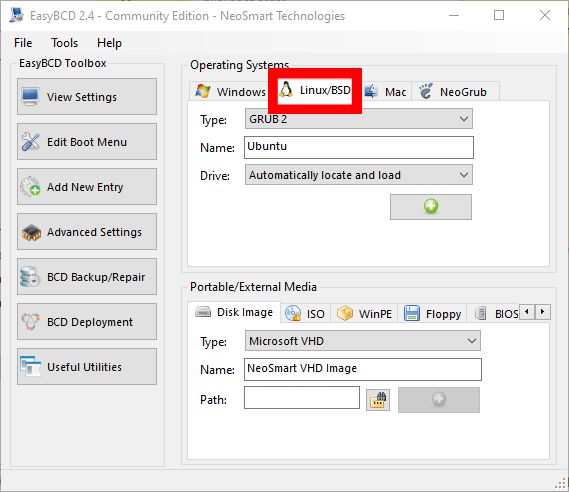

- #GRUB2 WINDOWS 10 BCD HOW TO#
- #GRUB2 WINDOWS 10 BCD INSTALL#
- #GRUB2 WINDOWS 10 BCD PC#
- #GRUB2 WINDOWS 10 BCD FREE#
However, if your distribution uses GRUB 2, as most Linux distributions do, select it from the Type dropdown menu, then modify the Name field to suite. If your distribution still uses that version of GRUB, then you just need to modify the Name field to reflect the distribution you are adding and select the partition where you installed GRUB from the Device dropdown menu.

By default, GRUB (Legacy) should be preselected in the Type dropdown menu. To add the entry, click the Add New Entry tab. It should start if installation is successful.
#GRUB2 WINDOWS 10 BCD INSTALL#
Note: This also applies to any of the BSDs, like PC-BSD.Īfter downloading it, install it as you would any other Windows application.
#GRUB2 WINDOWS 10 BCD HOW TO#
The rest of this article shows how to use it to add an entry for any Linux distribution in the Windows boot menu.
#GRUB2 WINDOWS 10 BCD FREE#
The best graphical application that I have found to help you accomplish that task, is EasyBCD, a free application (free for personal use, that is) from NeoSmart Technologies. After that, you must then add an entry for the Linux distribution in the Windows boot menu. To make managing your dual-boot system less of a hassle, especially when both operating systems are installed on the same hard drive, the recommended location (for the Linux boot loader) is in the first sector of the Linux distribution’s boot or root partition. It could either go in the target hard drive’s Master Boot Record (MBR), or in the first sector of its own boot or root partition. One of the most important decisions you have to make when dual-booting Windows and your favorite Linux distribution, is where to install the Linux boot loader. For first time users of Linux, that is the easiest way to keep using Windows, while getting used to their choice of Linux distribution. for example:ġ- " With EasyBCD, it is possible to add entries for Linux" ( how?)Ģ- "instead of choosing to install GRUB to the bootsector as is traditionally done when opting to use EasyBCD to control your boot menu, choose to install GRUB to the MBR (or disk, in this case) and make it the main bootloader for your PC" (the sentence " choose to install GRUB to the MBR (or disk, in this case) and make it the main bootloader for your PC" how to install GRUB to the MBR what disk are you talking about.Dual-booting any version of Microsoft’s Windows operating system with a Linux or BSD desktop or server distribution is a very common practice. Kindly please provide me with a more detailed version. I would like to do that but i did not understand the way. You can still use EasyBCD to control the Windows boot menu and set up multi-boots and re-configure Vista+ entries in the BCD boot menu, but with the GRUB2 EFI menu loading first, you can use that to boot into Linux and to chainload NTLDR to boot into Windows 9x.
#GRUB2 WINDOWS 10 BCD PC#
You can add the Windows boot menu to the GRUB2 EFI boot menu – in this case, you’ll see GRUB’s boot menu when your PC starts, and from there you can choose Windows.

When installing Linux or any other 3rd party OS that ships with its own bootloader, instead of choosing to install GRUB to the bootsector as is traditionally done when opting to use EasyBCD to control your boot menu, choose to install GRUB to the MBR (or disk, in this case) and make it the main bootloader for your PC. Since the Windows boot manager running in UEFI mode does not support the loading of legacy and non-Microsoft operating systems, another option is possible. With EasyBCD, it is possible to add entries for Linux and older versions of Windows to the top-level BCD menu seen when your machine first boots. Option 3: Use GRUB2 EFI as your main boot managerĮasyBCD controls the Windows boot menu, and has traditionally been used as the primary boot manager. I have read in EasyBCD page: EasyBCD and UEFI The laptop is now directly booting into Windows 10. The installation started and the only option in the prompt was restart, so I clicked restart. I choose the '/' partition and clicked install. I selected the free space partition I made earlier, and clicked + to add a SWAP partition equal to my RAM (16 GB), and another separate 2 GB as boot, and another one with the rest of the space as a '/' (root). I also chose the boot order priority to make UEFI:USB the first choice (I am sure that Windows 10 was installed with UEFI - I checked that already) and then I disabled 'Quick Boot on shutdown' in Windows 10.Īfterwards, I restarted my PC and booted from the Live USB, Ubuntu installer showed up. I restarted my laptop and entered the BIOS, I disabled Quick Boot and Secure Boot.

In my case I shrunk one partition of and I downloaded the Ubuntu 16.04 ISO, and I made a live usb using Rufus. I wanted to have ubuntu-16.04, with a dual boot for both Operating systems.


 0 kommentar(er)
0 kommentar(er)
